Fast becoming an icon for its trout fishing on the central tablelands, Thompsons Creek Dam has been open to fishing for about 15 years. Over this period it has endured the highs and lows of droughts and floods along with high water temperatures and algal blooms, but one thing has remained constant: the trout fishing opportunities.
Coming under NSW DPI Fisheries law, ‘Thommos’ (as it’s known by many) has officially been given Trophy Dam status. Trophy Dams under the NSW DPI Fisheries allow only artificial lure and fly to be used to catch fish, and there is a bag limit of two fish per person per day. No bait fishing is allowed in this dam, and that includes artificial baits such as and similar to Berkley PowerBait. Despite signage in the car parking area outlining all angling laws, and further signage by Energy Australia as to their access laws, some anglers have been seen illegally bait fishing in this dam. If you see someone breaking the law you can report it to Fishwatch on 1800 043 536.
As a trout dam Thommos is quite unique in that it is filled by pumping water from Lake Lyell near Lithgow up through a pipeline rather than a natural inflow of a river or a creek. Because there are no navigable inflows for trout to migrate up and spawn, the local trout just simply swim around the dam in wintertime, getting crankier and crankier – but I’m getting ahead of myself here!
The beginning of winter on the central tablelands is usually when Jack Frost starts his visits, and anglers pull on their thick socks and heavy fleece. Time for trout at Thommos! As air and water temperatures cool it sends signals to the local trout that it’s time to put on that last bit of weight before the hard times of winter set in. That amorous urge takes hold and feeding becomes secondary to instinct to create the progeny for the next generation. The beetle hatches are over, the caddis are finished; there are a few late big moth hatches but at this time of year the fish aren’t too fussy and will take a wide variety of lures and flies. This doesn’t last though!
My advice for early winter is to use what you feel confident with. Soft plastics are very popular with anglers at Thommos at any time of year and they have a good reputation in winter. I’ve found that 3” and 4” split and paddle tails work well, and if you like fishing the wind-blown shore as I do then it’s just a matter of using heavier jighead to make casting easier.
I rarely jig plastics at Thommos. Instead, I let my plastic sink to my chosen depth and then commence a very slow roll (constant winding). Other anglers may tell you different though, and there’s no harm in trying a range of approaches.
If the weather is flat enough, small bibbed minnows will also work well. It is a matter of casting distance and covering water with your lure. NSWFM Central Tablelands columnist Glen Stewart has consistently caught fish on OSP Dunk Minnows and I know jointed Rapala minnows also rate up at Thommos during this period.
As a general rule rainbow trout are quite pelagic in their behaviour in most large stillwaters, but at this time of year they will be searching/smelling for any inflows that may allow an attempt to spawn. Of course, there are no inflows to speak of here so the rainbows go on an endless quest for a couple of months, patrolling the perimeter. It’s a great time to intercept fish with a lure or fly nearly anywhere around the dam.
For this I like a slight onshore breeze but also I prefer deep edges where fish will track a depth contour. Depending on dam water levels there are a few sandstone drop-offs around the eastern bank, and the old quarry on the western bank is also very popular with anglers at this time of year (please remember you are not allowed to fish from the entire length of the rock-fill dam wall; heavy fines have already been issued).
Other lures to carry with you at Thommos are the ubiquitous Tassie Devil, Cobra or one of their many clones. Popular colours include pink, yellow, chartreuse and white. I’m sure your favourite will work just fine as long as you keep the retrieve slow so that the lure darts, dives and weaves. Small spinners such as Celtas and Mepps also work well if you can cast them an effective distance.
As winter pushes on and the proper chill sets in the fishing techniques will change. The rainbow trout begin to gather in small groups and begin to search out other small groups until finally they find the most suitable areas in which to try and spawn. This is usually a wind-blown shoreline that has suitable gravel around its perimeter. These ‘bank spawners’ will come into very shallow water in quite large numbers at times and can be found in various locations around the dam. You’d best put your walking boots on.
Watching masses of trout in the shallows certainly is a spectacle to behold, and it’s an event that few will see elsewhere. The law dictates that these fish are fair game to lawful methods of angling, but anglers still debate the ethics of it, quite heatedly at times, on both paper and web forums. Catching these fish ‘fairly’ is fortunately not that easy, and both tackle and techniques need to be honed to perfection. Get it right and you will remember it for a long time, but get it wrong and you will be absorbed for hours in the most frustrating fishing imaginable!
These spawning fish offer no food value, as their flesh is soft and tasteless. From a sportfishing point of view they are not great performers either, but they are generally quite big fish so if you use light finesse tackle and techniques they’ll keep you honest. Flyfishing techniques have long been touted as the most efficient way of catching these fish, but typically accuracy and presentation is the key so practice makes perfect which ever method you choose.
Offerings are generally very small. Fly anglers will be casting a combination of a dark nymph and a glo bug or similar. Spin anglers will be flicking micro plastics or even weighted glo bugs. If you can be stealthy enough and the fish haven’t been disturbed for a while, even spotted dog style minnow will work. These groupings of fish soon lose interest in the abundance of different hardware that gets thrown at them, so your first cast will be your best chance at catching one of these big fish.
These spawning aggregations disperse in time, depending on weather and location. The probability of these fish successfully spawning is extremely unlikely but not impossible. While expensive to initially breed, the stocking of triploid trout (a trout that cannot breed but will eat all year round) every five years would be an interesting proposition for this dam.
Once the frenzy of spawning is over this fishing will begin to return to normal, with general lure casting and fly methods being more favourable. The fish will be hungry from the rigours of spawning and will once again feed more willingly on a variety of food. This is my favourite time to fish soft plastics. They are just too edible looking and that’s what the fish are now after. My personal favourites include Berkley 3” Power Minnows and Ecogear Grass Minnows in a similar size. Once again, for distance and depth there are few better lures for searching than the indelible Tassie Devil or a metal trout spoon.
With the annual stocking by DPI Fisheries there are quite a few year classes of fish found in Thommos so there’s always plenty of diversity of size available at any time of year. During the winter period the smaller, bright silver fish are a much better eating proposition, even if they are considerably smaller than the spawners. These yearlings are generally perfect specimens, still growing fast and not old enough to spawn yet they will feed hard during the winter period on gudgeons, aquatic snails and fish eggs. Weighing up to about 750g, these are superb smoked whole or baked fresh in the oven, and you won’t be disappointed in their performance on the end of your line either.
The winter period at Thompsons Creek Dam certainly has its tough times, mainly when the weather restricts effective fishing methods. However, with a bit of true grit and warm clothing the fishing can be better than good, even for consistently large trout.
Facts
THOMSONS CREEK DAM
Location: NSW Central Tablelands, between country towns of Wallerawang and Portland.
Access: Walking access only. Car parking area is 15 minutes’ walk from the dam.
Regulations: A NSW fishing licence is required to fish TCD. Thompsons Creek Dam has a Trophy Dam status which permits the use of artificial lure and fly only. There is a two fish bag limit per person per day. No bait fishing is allowed.
Local tackle shop: Lithgow lure & Tackle – 02 6352 1276
Accommodation: Wallerawang Black Gold Country Cabins – 02 6355 7305, Royal Hotel Wallerawang – 02 6355 7023
Further information: Lithgow Information Centre – 02 6350 3230
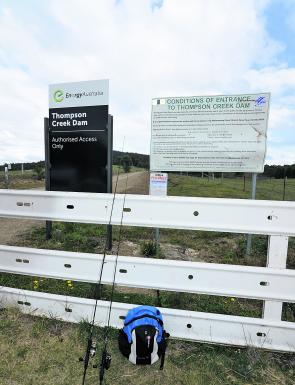
On arrival at the car park, make sure you read the signage before fishing at Thompsons Creek Dam.
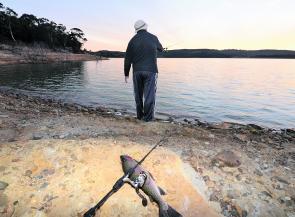
The winter evenings at Thommos are crimson in all respects.
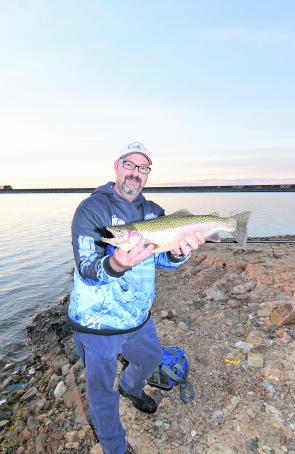
Alex Hickson with a perfectly coloured and proportioned early winter trout from TCD. It’s the sort of fish that you can expect to catch at this time of year.
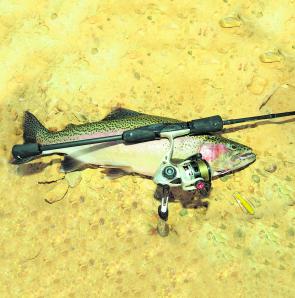
Whether you’re casting small soft plastics, heavier spoons or Tassie Devil style lures, modern lightweight finessing tackle is ideal for Thommos trout.

Alex Hickson puts the finishing touches on a typical TCD rainbow trout.
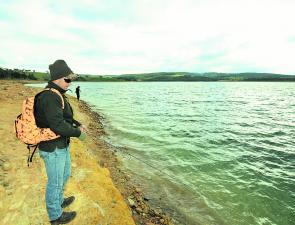
Depending on water levels there are several deep edges around TCD. These are great locations to cast a lure or fly.
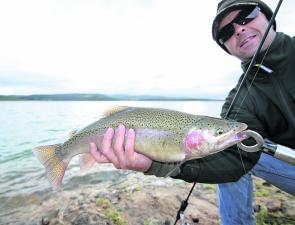
Dael O’Neil with a early winter TCD rainbow trout. This high altitude dam can experience severe weather changes on any given day so it pays to be prepared for the worst.
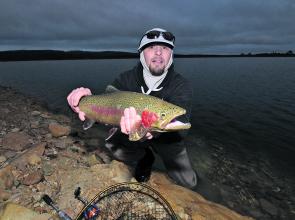
Chris Murray from Sydney has no qualms about setting the alarm clock for an early start at TCD because he knows it’s going to be worth it!
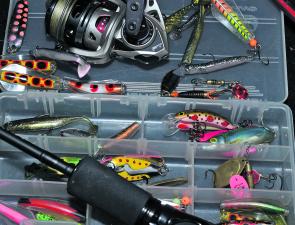
The author’s grab-and-go tackle box for Thompsons Creek Dam.
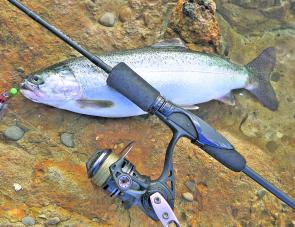
There is a good mix of year classes available at TCD. If you want to take a fish to eat, one of the smaller bright silver fish would be a good choice at this time of year.




